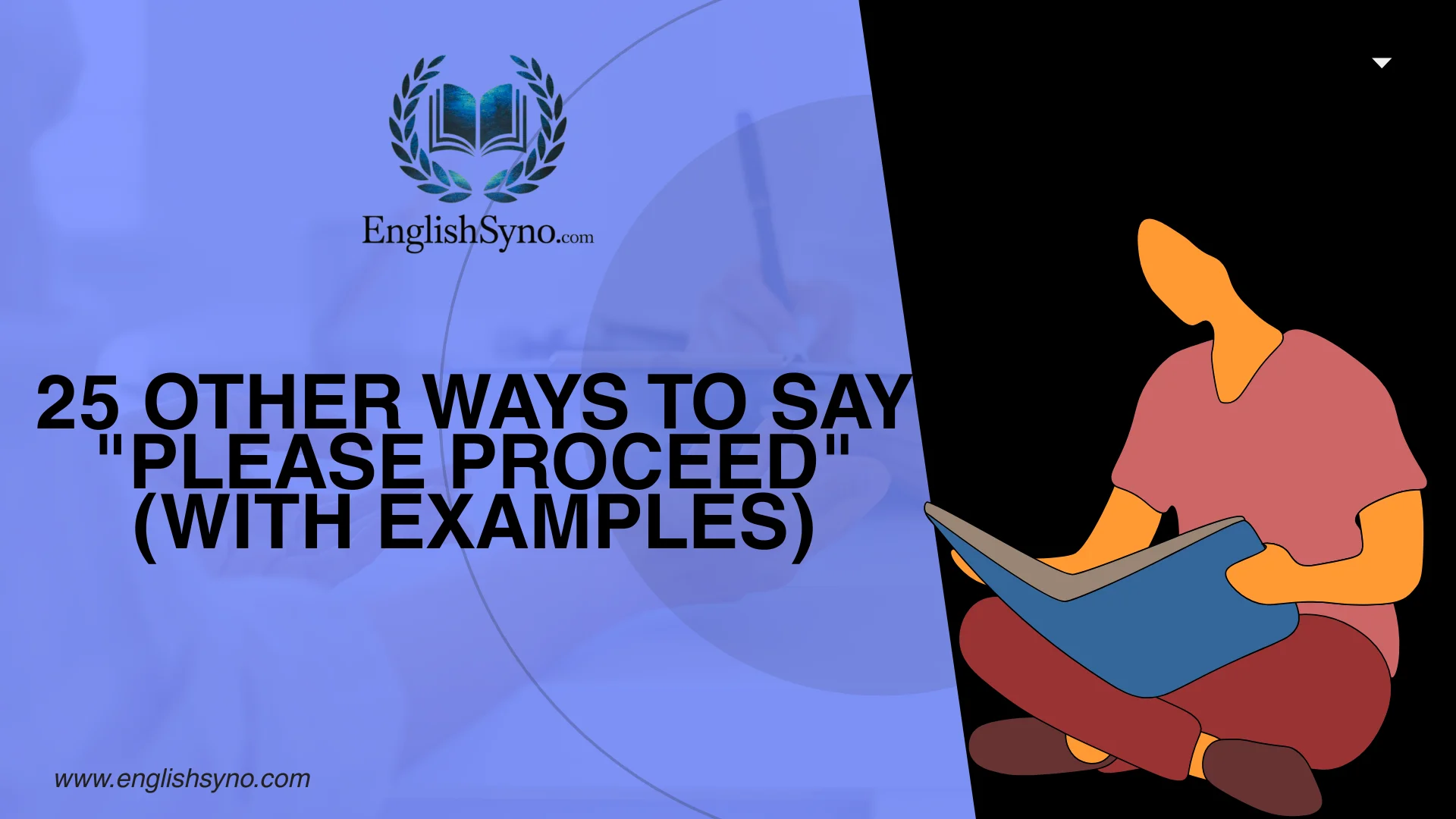In my professional journey, I often relied on the powerful phrase please proceed, which feels both correct and usable in work settings. Whether guiding someone to continue the next step of an action or process, or handling formal communication regularly, this phrase works smoothly in written English. I use it when asking for progress, ensuring I don’t sound harsh or rushed, keeping the interaction polite and professional.
A memorable moment came during a contract review when the documents were finally signed. I had to direct the client to another room to complete the final paperwork. Instead of lengthy instructions, I used the right tone and simply said, “Please proceed.” It was polite, clear, and showed how language can be powerful in the right context.
What Does “please proceed” Mean?
The phrase please proceed means to politely tell someone to continue or move forward with a task, action, or process. It balances formality with kindness, making it a professional yet gentle way to give direction.
When to Use please proceed
You use please proceed in situations where you want to give permission, encouragement, or direction without sounding forceful. For example, during a meeting, in emails, or when guiding someone in a step-by-step process.
Is It Professional/Polite to Say please proceed
Yes, please proceed is both professional and polite. It shows respect while maintaining clarity, making it suitable for both formal settings and considerate personal exchanges.
Pros or Cons
Pros:
- Sounds professional and polite
- Balances formality with warmth
- Works across contexts
Cons:
- May feel too formal in casual conversations
- It could sound a bit detached if overused
Go Ahead
Meaning/Definition: A friendly, everyday way of telling someone they are free to continue.
Explanation: Less formal than please proceed, but warm and inviting.
Detailed Email Example:
“Hi Sarah, you’ve done great work on the draft. If you’re ready, please go ahead and finalize the edits by tomorrow.”
Best Use: Casual work chats, supportive contexts.
Worst Use: Legal or formal contracts.
Tone: Friendly, relaxed.
You May Continue
Meaning/Definition: A polite way of granting permission.
Explanation: Works in structured or instructional settings.
Detailed Email Example:
“Hi John, the report looks good. You may continue with the final formatting and send it by Friday.”
Best Use: Professional communication.
Worst Use: Everyday casual chats.
Tone: Polite, formal.
Carry On
Meaning/Definition: Encourages persistence and ongoing action.
Explanation: Slightly British in tone, but adds charm.
Detailed Email Example:
“Team, the first phase looks excellent. Please carry on with the next steps as planned.”
Best Use: Team instructions.
Worst Use: Strict legal communication.
Tone: Supportive, motivating.
Move Forward
Meaning/Definition: Encourages progression toward the next stage.
Explanation: Often used in professional development or projects.
Detailed Email Example:
“Thanks for confirming the details, Daniel. You can move forward with scheduling the client presentation.”
Best Use: Projects, business contexts.
Worst Use: Casual, playful settings.
Tone: Professional, progressive.
By All Means
Meaning/Definition: Gives enthusiastic permission.
Explanation: Conveys warmth and encouragement.
Detailed Email Example:
“Hi Emma, by all means, go ahead with booking the venue. Your choice sounds perfect.”
Best Use: Friendly or encouraging replies.
Worst Use: Highly formal contracts.
Tone: Warm, encouraging.
Feel Free to Continue
Meaning/Definition: Invites without pressure.
Explanation: Shows openness and reassurance.
Detailed Email Example:
“Thanks for the update, Alex. Feel free to continue with the testing phase whenever you’re ready.”
Best Use: Collaborative contexts.
Worst Use: Formal directives.
Tone: Relaxed, inviting.
Whenever You’re Ready
Meaning/Definition: Suggests flexibility and care.
Explanation: Perfect for creating comfort.
Detailed Email Example:
“No rush, Priya. Whenever you’re ready, you can begin drafting the proposal.”
Best Use: Sensitive situations.
Worst Use: Strict deadlines.
Tone: Gentle, empathetic.
Kindly Proceed
Meaning/Definition: Similar to please proceed, but slightly softer.
Explanation: Adds a tone of courtesy.
Detailed Email Example:
“Hello Mr. Khan, kindly proceed with completing the required documents.”
Best Use: Polite business exchanges.
Worst Use: Informal casual chat.
Tone: Formal, polite.
Continue Onward
Meaning/Definition: Suggests steady progress.
Explanation: Encourages persistence.
Detailed Email Example:
“Team, great progress so far. Please continue onward with phase two.”
Best Use: Projects, teamwork.
Worst Use: Everyday personal talk.
Tone: Motivating, formal.
Let’s Keep Going
Meaning/Definition: Includes the speaker in the action.
Explanation: Team-focused encouragement.
Detailed Email Example:
“Everyone, this is coming together well. Let’s keep going with the testing stage.”
Best Use: Group efforts.
Worst Use: Strictly formal exchanges.
Tone: Inclusive, motivating.
Keep It Going
Meaning/Definition: Encourages someone not to stop but to maintain momentum.
Explanation: Useful when acknowledging good work and urging continuation.
Detailed Email Example:
“Hi James, your efforts on the draft look great. Keep it going and finish the remaining chapters by next week.”
Best Use: Team motivation, progress updates.
Worst Use: Legal or formal approval contexts.
Tone: Encouraging, informal.
Proceed When Ready
Meaning/Definition: Gives the other person control over timing.
Explanation: Signals respect for their pace.
Detailed Email Example:
“Hello David, I’ve reviewed your proposal. Please proceed when ready with the client submission.”
Best Use: Respectful professional emails.
Worst Use: Emergency instructions.
Tone: Courteous, flexible.
Take the Next Step
Meaning/Definition: Directs someone to progress to the following stage.
Explanation: Works best for multi-step tasks.
Detailed Email Example:
“Maria, excellent job on the initial designs. Now, take the next step and finalize the mockups.”
Best Use: Projects and phased tasks.
Worst Use: Informal chats.
Tone: Direct, professional.
Make Your Move
Meaning/Definition: Encourages decisive action.
Explanation: Motivates initiative.
Detailed Email Example:
“Sam, the investors are waiting. It’s time—make your move and share the pitch.”
Best Use: Motivational or decision-driven contexts.
Worst Use: Formal corporate emails.
Tone: Bold, energizing.
Push Forward
Meaning/Definition: Encourages persistence despite challenges.
Explanation: Reflects resilience and determination.
Detailed Email Example:
“Team, I know this project has hurdles, but let’s push forward and meet the delivery date.”
Best Use: Motivational team talks.
Worst Use: Polite permission emails.
Tone: Motivating, strong.
You May Go Ahead
Meaning/Definition: A softer variation of “go ahead.”
Explanation: Adds a sense of polite permission.
Detailed Email Example:
“Hi Clara, you may go ahead and send the client the revised quotation.”
Best Use: Formal workplace settings.
Worst Use: Friendly casual chats.
Tone: Polite, respectful.
Advance
Meaning/Definition: A concise way to encourage progress.
Explanation: More formal and directive.
Detailed Email Example:
“Please advance with the next stage of testing and share results by Monday.”
Best Use: Business reports, projects.
Worst Use: Friendly talk.
Tone: Formal, commanding.
On You Go
Meaning/Definition: A light, encouraging nudge to continue.
Explanation: Casual and supportive.
Detailed Email Example:
“Nice work on the updates, Mia. On you go with the last phase.”
Best Use: Informal encouragement.
Worst Use: Formal business writing.
Tone: Friendly, relaxed.
Feel Free to Move Forward
Meaning/Definition: Blends encouragement with freedom.
Explanation: Invites the other person to take initiative.
Detailed Email Example:
“Hi Luke, feel free to move forward with the project presentation whenever you’re ready.”
Best Use: Collaboration and teamwork.
Worst Use: Strict deadlines.
Tone: Encouraging, open.
Continue at Your Pace
Meaning/Definition: Shows empathy by respecting someone’s timing.
Explanation: Good when avoiding pressure.
Detailed Email Example:
“Don’t worry about rushing, Anna. Continue at your pace and send me the draft when it’s ready.”
Best Use: Supportive messages.
Worst Use: Urgent tasks.
Tone: Empathetic, considerate.
Carry Forward
Meaning/Definition: Move something into the next stage or phase.
Explanation: Slightly formal but polite.
Detailed Email Example:
“Please carry forward the agenda items to next week’s meeting.”
Best Use: Business and academic contexts.
Worst Use: Informal chats.
Tone: Formal, polite.
You’re Clear to Go
Meaning/Definition: Grants permission in a clear, decisive way.
Explanation: Often used when giving approvals.
Detailed Email Example:
“After reviewing your draft, you’re clear to go with publishing the article.”
Best Use: Approval or greenlight emails.
Worst Use: Everyday conversations.
Tone: Authoritative, professional.
March On
Meaning/Definition: A motivational phrase with military undertones.
Explanation: Suggests strength and resilience.
Detailed Email Example:
“We’ve faced some challenges, but let’s march on toward our project goals.”
Best Use: Motivational settings.
Worst Use: Casual chats.
Tone: Strong, determined.
All Set, Go Ahead
Meaning/Definition: Signals readiness and permission.
Explanation: Combines reassurance with encouragement.
Detailed Email Example:
“Hi Jenny, everything is approved. You’re all set, go ahead with the order.”
Best Use: Giving the final greenlight.
Worst Use: Very formal letters.
Tone: Reassuring, polite.
It’s Time to Begin
Meaning/Definition: Marks the start of an action or process.
Explanation: Encourages someone to take the first step.
Detailed Email Example:
“Dear Team, it’s time to begin phase three. Let’s get started with enthusiasm.”
Best Use: Starting meetings and projects.
Worst Use: Casual daily talk.
Tone: Formal, encouraging.
Final Thoughts
Finding the right words can transform the way we connect with others, whether in professional emails, team updates, or casual exchanges. The phrase please proceed may be small, but it carries weight, showing respect, clarity, and warmth. Exploring alternatives gives you the flexibility to adapt your message to different situations—sometimes more formal, sometimes more personal.
Using expressions like go ahead, you may continue, or carry on not only communicates direction but also reveals your ability to be thoughtful and considerate. In business, this could make your communication appear more polished; in personal life, it can make others feel more valued.
Ultimately, words aren’t just about passing instructions—they’re about building trust and creating a sense of connection. By choosing from these 25 alternatives, you can strike a balance between being clear, empathetic, and professional. The right tone ensures that your message is received not just as information, but as genuine guidance.
FAQs
What does “please proceed” mean?
“Please proceed” means politely telling someone to move forward with an action, task, or process respectfully and professionally.
Is “please proceed” formal?
Yes, it’s considered formal and polite, making it suitable for business communication, official instructions, or formal events.
Can I use “please proceed” in casual conversations?
You can, but it may sound too formal. Alternatives like “go ahead” or “carry on” feel more natural in casual settings.
What is a synonym for “please proceed”?
Synonyms include go ahead, continue, kindly proceed, and move forward, depending on tone and context.
Is “please proceed” polite?
Yes, it’s polite because it includes “please,” which softens the instruction and adds respect.
How do you use “please proceed” in an email?
Example: “Thank you for sending the draft. Please proceed with the final edits and share by tomorrow.”
What’s the difference between “please proceed” and “go ahead”?
“Please proceed” is more formal and professional, while “go ahead” is casual and conversational.
Can managers say “please proceed”?
Yes, managers often use it to politely instruct employees to move forward with tasks.
Is “please proceed” outdated?
No, it’s still widely used in professional and formal settings today.
Can “please proceed” sound rude?
Not usually. However, if overused or said without warmth, it might feel robotic.
What’s a better phrase for teamwork?
“Let’s keep going” or “carry on” often works better in team environments.
Is “please proceed” American or British English?
It’s common in both American and British English, though “carry on” is more British.
Can “please proceed” be used legally?
Yes, it’s often used in legal or contractual communication where formality is important.
Why add “please” to “proceed”?
Adding “please” makes the phrase softer, more respectful, and polite.
What is the best alternative for a casual tone?
For a casual tone, phrases like go ahead, on you go, or keep it going work best.



